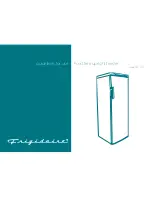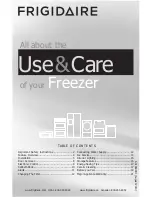
11
FREEZER COMPONENTS
1. Inner door latch:
Always lock the inner door latch when the inner door is closed.
2. Inner door:
This prevents cold air from escaping when the outer door is opened. Always be sure to
close the inner door securely before closing the outer door. The inner door can be removed for cleaning
or defrosting [page 51].
3. Outer door latch:
When closing the outer door push the latch until the latch is locked in place.
Provision has been made for use of an additional padlock (not included).
4. Keyhole:
Turn clockwise to 180
o
with a key and the outer door is securely locked.
5. Air intake vent (grille):
Do not block this vent to keep the proper cooling performance.
6. Leveling feet:
These are screw bolts used to install and fix the unit. Adjust the height of the leveling
feet by turning the screw bolts until 2 front casters are away from the floor.
7. Caster:
4 casters are provided to facilitate moving of the cabinet. For the installation, adjust the
leveling feet so that the front 2 casters cannot contact with the floor.
8. Condenser filter (behind the grille):
This filter prevents the dust from accumulating on the
condenser. A dusty condenser filter may cause failure of refrigerating device. Clean the condenser
filter once a month [page 50].
9. Space for temperature recorder:
A temperature recorder (optional) can be mounted here so that
the chamber temperature can be recorded automatically [page 55].
10. Access port (rear and bottom):
These ports are used to pass the sensor or cable of measuring
equipment, the sensor of a temperature recorder (optional), or the nozzle of a back-up cooling kit
(optional) to the chamber.
11. Fixture (on back side):
Use the fixtures and secure the unit to a wall with a strong rope or chain
[page 16].
12. Power switch:
This is the power switch of the unit.
(
ON=“l”,OFF=“
○
”
)
13. Temperature setting knob (TEMP. SET)*:
It is the knob which adjusts injection set temperature of
the backup cooling kit [page 56].
14. Backup power switch (BACK UP)*:
Power switch of the backup cooling kit [page 56].
15. Backup test switch (TEST)*:
It is the switch to confirm that the backup cooling kit can inject liquid
CO
2
[page 56].
16.
Remote alarm terminal:
A remote alarm device (separately available) can be connected to this
terminal. The remote alarm relays the alarm to an operator in a remote location if the unit is un attended
[page 14].
17. Battery switch:
This is an
ON-OFF switch for the battery for the power-failure alarm. Always turn
this switch on when the unit is operating to ensure that the power-failure alarm is working. Turn this
switch off when the unit is not used for a long period in order to protect the battery.
18.
LCD touch panel:
[pages 12 - 13]
19. USB port:
Insert USB memory to export operations and alarms log [pages 35 - 42].
Note:
It is impossible to use USB memory which is required password input.
20. Air intake port:
This operates automatically when the outer door is closed. The outer door can be
opened easily because this port intake the outer air and the pressure difference between the chamber and
outside is deleted. During the operation of this port, the suction noise arises, but this is not a malfunction.
21. Air intake port (Manual):
Adjust the pressure difference inside and outside the chamber manually to
open the outer door smoothly [page 14].
* When an optional backup cooling kit is installed.












































